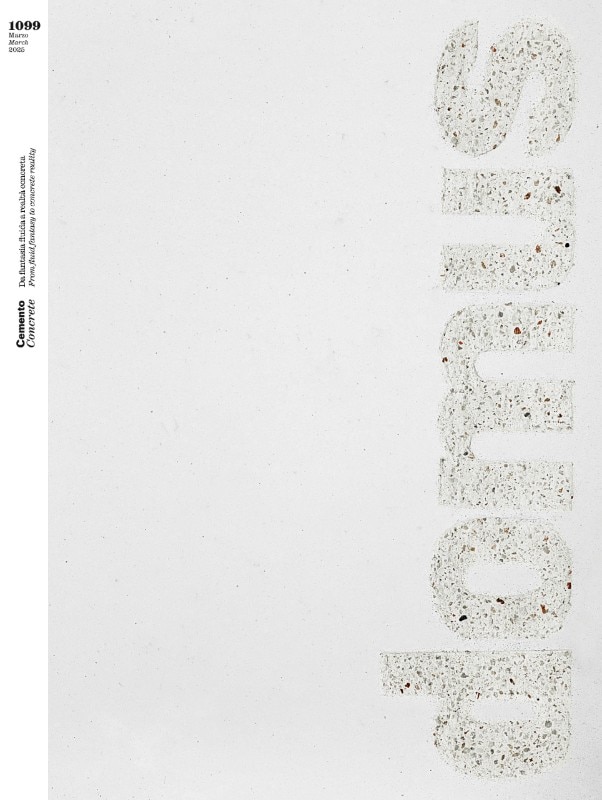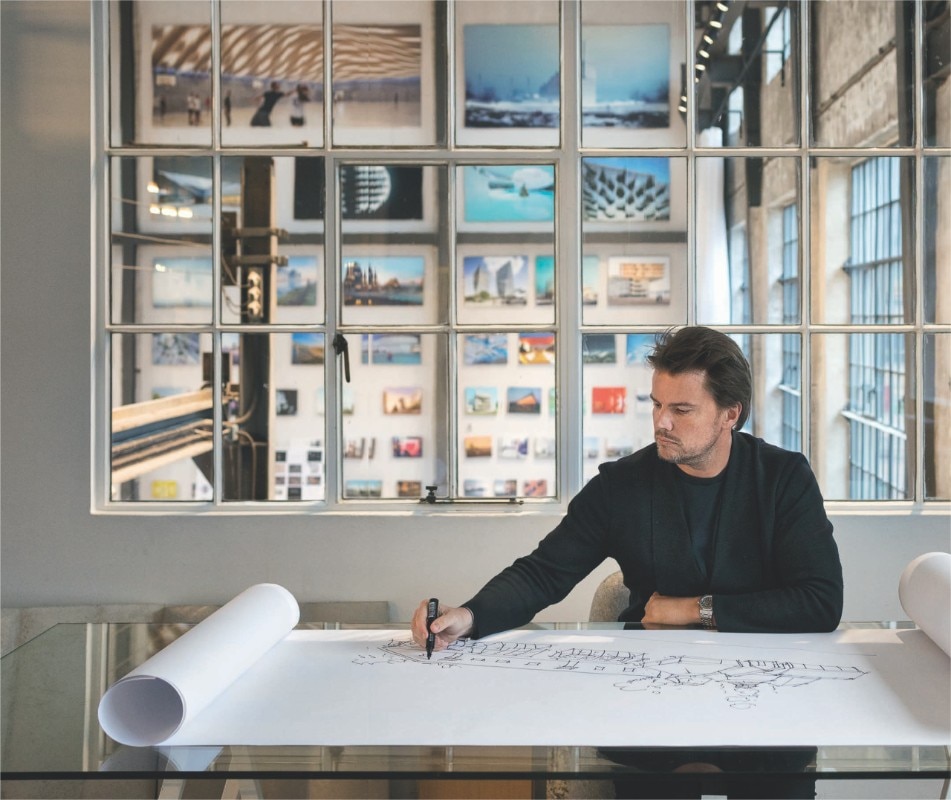Concrete is the pariah of architecture. Synonymous with social housing turned urban slums. Boxy boring architecture sacrificing beauty for budget. It is the poster child of the construction industry’s role in the climate crisis, constituting four to eight per cent of global carbon emissions.
Concrete is also the hardworking hero of the 21st century. It is our roads, bridges and tunnels. It is our foundations, sewers, basements, plantrooms, walls and columns. Even if Copenhagen seems entirely finished in brick, the city is almost consistently made from prefabricated concrete elements. The resulting carbon footprint of the one-size-fits-all of architecture has made it the environmental scapegoat of the built environment. But if you are a big part of the problem, you have to play a leading role in the solution.
Originally invented by the Romans, using volcanic ash from Vesuvius, it is the material of the great Pantheon. In the 19th century, a French gardener stumbled upon reinforced concrete by experimenting with steel rods and chicken wire.

But the greatest protagonist propelling concrete to the citybuilding role it has today is undoubtedly Le Corbusier. His Five Points of Architecture clearly defined the architectural freedoms of reinforced concrete. But like all revolutions, what starts as a declaration of freedom inevitably hardens into rigid dogma. Le Corbusier’s purist pursuit of concrete devolved into crane track urbanism. Endless outskirts of sad satellite cities where the new-found freedoms settled into the norm, absent the craft and quality of artisanal masonry and woodwork.
When I joined the art academy in 1993, I had been raised on a discursive diet that concrete was bad. It lasted until my second study trip through Germany, Switzerland and France, where I was exposed to some works of architecture that changed my perspective. First, Rudolf Steiner’s expressive anthroposophic cathedral the Goetheanum reminded me that the relentlessness of concrete social housing was not an inherent attribute of the material itself. It was reaffirmed by Corbu’s Ronchamp chapel with its Smurf-like friendliness and voluptuous volumes. At the Vitra Campus’s architectural playground, I was moved by the almost oxymoronic juxtaposition of Zaha Hadid’s Fire Station and Tadao Ando’s Conference Pavilion. The Fire Station had just opened and constituted the first built example of Hadid’s until then seemingly unbuildable vision of architecture.

I had been fascinated by the futuristic dynamism and colourful expressions of her architectural paintings. But her work seemed to rely on exaggerated perspectives and I suspected that a built iteration would require concessions to the forces of gravity, function and budget. I was proven very wrong. In the dressing rooms, the tilted concrete planes of walls, floors and ceilings seemed to barely meet. Skinny tubular steel columns were visibly inadequate to support floating shards of concrete overhead. The material I was taught to dismiss was the secret to materialise a supremacist painting in built form. Paradoxically, the greatest surprise was Ando’s Conference Pavilion. On the surface, it seemed to fit the bill of boring and boxy. But the austere yet elegant orchestration of space and light made me realise that fluidity could exist in orthogonality. And the tactility. The concrete surfaces felt like silk to the touch with texture and colour like a precious stone.
I returned with my eyes opened to the seemingly magical properties of this controversial substance. My new-found curiosity for concrete led me to discover Paul Virilio’s Bunker Archeology. His work with Claude Parent was like an artistic appropriation of the found object of the Nazi bunkers littered along the French coast after World War II. I stumbled across Sigurd Lewerentz’s flower shop in Malmö with its clipped-on sheets of glass, its exposed tinfoil vapour barrier and electrical work arranged like vines climbing the raw concrete wall. It all came together in Delirious New York when Rem Koolhaas compared the diagram of Salvador Dalí’s Paranoid-Critical Method to the recipe for casting concrete. A droplet of unformed paranoia sustained by the crutches of critical thought. Or more literally, an amorphous liquid poured into a wooden formwork. Once the liquid hardens and the formwork is removed, the liquid has solidified into the arbitrary form inherited by the now vanished mould. Standing in the absence of support. From fantasy to reality. Mind turned into matter.
When we designed our own HQ in Copenhagen, we had just finished some experiments with mass timber, an effective way to reduce a building’s embodied carbon footprint. However, our site was on the tip of a pier surrounded by saltwater and it would be a maintenance nightmare of chemical warfare to protect the wood from deteriorating. Inside, all seven floors connect visually and physically to eliminate segregation in a multistorey work environment. By code, only 25 per cent of the interior could be wood. It became clear that concrete was the solution for functional, economic and experiential reasons. We went on a cementitious safari to find ways to lower the embodied carbon. We found a mixture that replaces 35 per cent of the cement with clay, and when left exposed the concrete keeps curing recarbonising CO2 from the air.
The thermal mass allowed us to naturally ventilate the building and have all floors open without sprinklers. It is clear that there is great potential if we invest in updating concrete to address current climatic challenges.
I cannot imagine a future without concrete. This issue is a testament to its power and potential.

Leah Ellis with Sublime Systems is using bacteria to digest limestone into cement without the energy demands or CO2 emissions that come with conventional production. Icon co-founder Jason Ballard is harnessing robotic construction and AI to 3D-print entire neighbourhoods and create the first permanent presence on the Moon. Philippe Block is using sophisticated manufacturing to minimise concrete use with beautiful Pier Luigi Nervi-style vaulted slabs. HArquitectes are utilising material from demolished buildings to create beautiful blocks for the buildings that replace them. Christian Kerez has turned parking structures into iconic undulating urban landscapes. Alejandro Aravena has created a brutalist concrete canyon at the heart of Lisbon, and Thomas Phifer has cast a museum of snow-white concrete. Studio Moto has raised a ring of sand on a Belgian beach like a solidified sculpture.
It is clear that there is great potential if we invest in updating concrete to address current climatic challenges. I cannot imagine a future without concrete.
Tham & Videgård, Pezo von Ellrichshausen and Chenchow Little Architects are exploring monolithic concrete elements, while Julien De Smedt, MBL Architectes and Keisuke Oka are exploring the limitless formal freedoms of concrete. Katja Schenker is using concrete to contain found objects producing artworks like giant blocks of nougat. Finally, Ensamble Studio explores the oxymoronic nature of concrete in their factory, where they design by rehearsing fullscale construction. Cranes in lieu of foam cutters.
As concrete finds itself more criticised than ever, I believe this issue shows that it is at the precipice of a social, environmental and artistic renaissance. Concrete’s plasticity allows it to be moulded by the demands, desires and values of a new era. Abstract ideas turned into concrete reality.
Opening image: Bjarke Ingels. Image by Wallpaper


